Through the bustling, bazaar-like streets of Xiguan (西关) in Guangzhou, it was hard not to get distracted by vendors selling socks and phone cases. But my destination that day was Baohua Noodles (宝华面店), an eatery loved by the locals.
Sitting still with the noise buzzing around me, my mom and I enjoyed a bowl of wonton noodles and pig trotter noodles—umami-rich broth, perfectly chewy noodles, and juicy wontons bursting with bouncy shrimp meat. That was six years ago when we visited Guangdong’s capital and neighboring town Shunde (顺德), one of our first food-focused trips in China (followed by Guiyang, Xi’an, and smaller Sichuan cities). The southern province of Guangdong was high on my list. We spent a few days eating our way through dim sum, Shunde-style hot pot, buffalo milk double-skin pudding, and tang sui (sweet soup desserts)—a world apart from the cha chaan teng I had experienced back in Europe.
A Brief History of Cantonese Wonton Noodles
Wontons vary across different regions of China. In Sichuan, they are called chao shou (抄手) and are typically made with pure pork. In other parts of China, they are known as hun tun (馄饨). The Cantonese version, however, is the most well-known outside of China—the name wonton itself comes from its Cantonese pronunciation yun tun (云吞).
Cantonese wontons are traditionally filled with a combination of pork and shrimp (or sometimes only shrimp) and paired with thin, chewy noodles. Wontons were first introduced to Xiguan in the early 20th century by vendors from Hunan. Over time, shrimp were added to the filling and eggs to the dough, transforming it into the beloved Cantonese specialty it is today. Later, Mak Woon-chi brought this dish to Hong Kong, founding the famous Mak’s Noodles. Now, wonton noodle soup (云吞面) is one of the most iconic Cantonese noodle dishes—so much so that it was even featured in Wong Kar Wai’s film In the Mood for Love.
Unlike Sichuan wontons, which are drenched in pungent chili sauce, Cantonese wonton soup emphasizes umami. A great bowl of wonton noodles comes down to three key elements: the wontons, the noodles, and the broth. At the eatery we visited, ordering a bowl of soup cost extra – a sign of craftsmanship. The broth was slowly simmered from pork bones, chicken, and dried seafood (typically dried flounder powder or scallops), sometimes with a secret ingredient unique to each shop. The result is a deeply flavorful, umami-packed broth.
The noodles are just as special. Known as bamboo noodles or Jook-sing noodles (竹升面), they are also called yinsi mian (银丝面), or "silver thread noodles." Thin, elastic, and chewy, they are made by mixing flour with duck eggs, and kansui (alkaline solution) and then pressed with a bamboo pole in a seesaw motion using body weight—hence the name.
Complicated as it might sound, this dish can be recreated at home with a few compromises. It’s a great weekend project: make a big batch of wontons, freeze them, and use them whenever you want a bowl. Scroll down for tips on making the broth and sourcing the perfect noodles and wrappers.
Recipe: Cantonese Wonton Noodle Soup (云吞面)
Ingredients
For the Wontons
(Makes about 45 wontons)
300g (10 oz.) ground pork (preferably with some fat)
240g (8 oz.) shrimp, shelled and deveined
4 tbsp water
1 tsp light soy sauce
1 tsp salt
1 tsp white sugar
½ tsp ground white pepper
2 tsp toasted sesame oil
1 tsp cornstarch
45-50 wonton wrappers, defrosted 1 hour before wrapping
For each bowl of noodles
50g dried wonton noodles / 100g fresh wonton noodles
2 cups (500 ml) shrimp pork bone broth or chicken broth (see note)
4-6 wontons
fish sauce, sesame oil, salt, and a splash of vinegar to taste
1 head of bok choy, quartered (or gai lan, young chives)
Instructions
To Make the Wontons
In a large mixing bowl, add the pork mince and slowly mix in 4 tbsp of water, stirring with chopsticks until a sticky paste forms. Add the soy sauce, salt, sugar, white pepper, sesame oil, and cornstarch, mixing until well combined.
Finely chop the shrimp into pea-sized pieces. Then, fold in the chopped shrimp in the pork and mix to combine.
Prepare a small bowl of water. Place about 2 tsp of filling in the center of a wrapper, dampen the edges with water, then fold into a triangle. Seal the edges, then fold in the two corners to meet in the middle, forming pleats and pinching the top into a "tail" shape. Alternatively, you can press down the filling with a spoon and use your thumb and pointing finger to pinch and seal the top.
Place finished wontons on a lightly floured surface to prevent sticking. Freeze any extra for later use.
To Make the Noodles
In a sauce pan, bring the broth to a light simmer and keep warm.
In a separate pot, bring water to a boil. Add fresh wontons and stir to prevent sticking. Cook for about 4 minutes, until the wontons are cooked through.
Add the noodles and cook according to the package instructions. During the last minute of cooking, blanch the bok choy. You can cook wontons, noodles and veggie in the same pot.
In a serving bowl, add seasoning, then layer the noodles, wontons, and warm broth. Top with bok choy and garnish with scallions. Season with fish sauce, sesame oil, salt, and a splash of vinegar to taste.
How to Make Better Wonton Noodle Soup at Home
The classic Cantonese dish takes hours to make, however, with the recipe, it’s fairly done in 2-3 hours (simmering the broth while folding the wontons). A nice weekend project leaving you wontons for the next days. There are, of course, plenty of shortcuts you can go to make this recipe more weeknight-friendly, for example with store-bought chicken or pork broth. But if you want the full experience, I highly recommend making the pork bone broth yourself!
The Broth: Heart of the Dish
Traditionally, chefs use homemade dried flounder powder (大地鱼粉, dadi yufen) by toasting sun-dried flounder over charcoal and grinding it into a fine powder. Since it’s hard to find outside of China (you can get it online in the US), I substitute dried shrimp and fish bouillon powder (I used one cube of this brand) to achieve a similar seafood depth. If you're using shell-on shrimp, save the shells and use them instead of dried shrimp in the broth. I can imagine a pinch of hondashi powder or a piece of kombu works here as well!
Recipe for the shrimp and pork bone broth
Makes 4 cups of broth, serves 2 bowls
1 pound, 450 g pork bones (eg. neck)
20 g (2 tbsp) soaked dried shrimp, or shrimp shells
2.4 L (10 cups) water
3 slices of ginger
3 shallot, halved
10 g fish bouillon powder (optional)
Salt and sugar to taste
Combine pork bones, shallots, ginger, and cold water in a pot. Bring to a boil and skim off any foam. Simmer for 1 hour, then add dried shrimp and fish stock powder. Cook on low heat for another hour, skimming foam occasionally. Strain the broth, discarding solids. Season with salt and sugar to taste
Choosing the Noodles and Wrappers
Traditionally, both wonton wrappers and noodles are made from the same egg noodle dough. Purists even insist on using only duck eggs instead of water for a richer texture. I used wrappers with added egg in a golden color, but you can use the square-shaped white wonton wrappers as well (don’t mistaken with dumpling wrappers).
For the noodles, the best option would be fresh or frozen wonton noodles that are made with egg and have alkaline, often labeled as 云吞幼面 or 竹升面. If they aren’t available, dried egg noodles labeled “wonton noodles” are a great alternative and can be found in most Asian grocery stores. They have a firmer, chewier texture than regular thin wheat noodles and don’t turn soggy as quickly. Another option is thin shrimp noodles (虾子面), which are made with shrimp stock in the dough and are used in some noodle shops. These add an extra layer of seafood flavor to the dish. After testing several types of noodles, my personal favorite is frozen fresh wonton noodles from my local Asian store. Once defrosted, they closely resemble the fresh bamboo noodles served in restaurants. However, proper defrosting is crucial—otherwise, they will clump together when cooked.
Wrapping Techniques
Cantonese wontons have a different shape than their Sichuan counterparts, as they’re folded into small pouches with "goldfish tails”, which is a bit more complicated than the Sichuan wontons’ pleads. It took me a few tries to master the folding technique, but once you get the hang of it, it’s quite easy. You can refer to the step-by-step instructions and the video on the Cantonese-style folding.
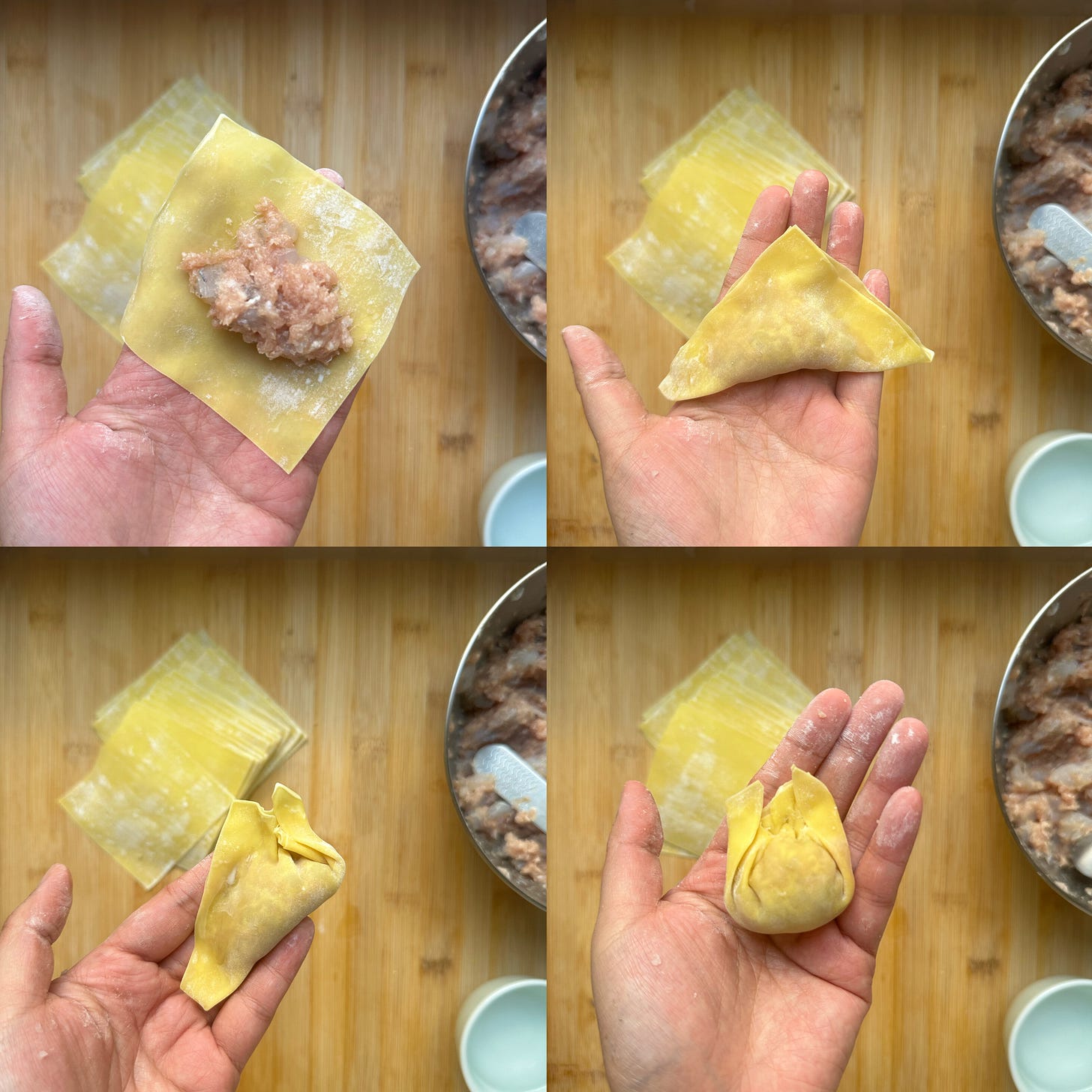
That said, if you’re already familiar with another way of folding wontons, feel free to use it—the shape won’t affect the taste or texture of the dish.
I recently came across a wonderful illustration from the book Cantonese Chef’s Classics (《粤厨宝典》), showcasing different wonton folding styles across China (from top to bottom: Guangzhou style, Northern Chinese golden ingot style, Sichuan golden ingot style).

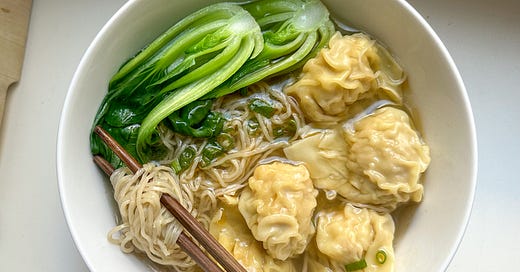


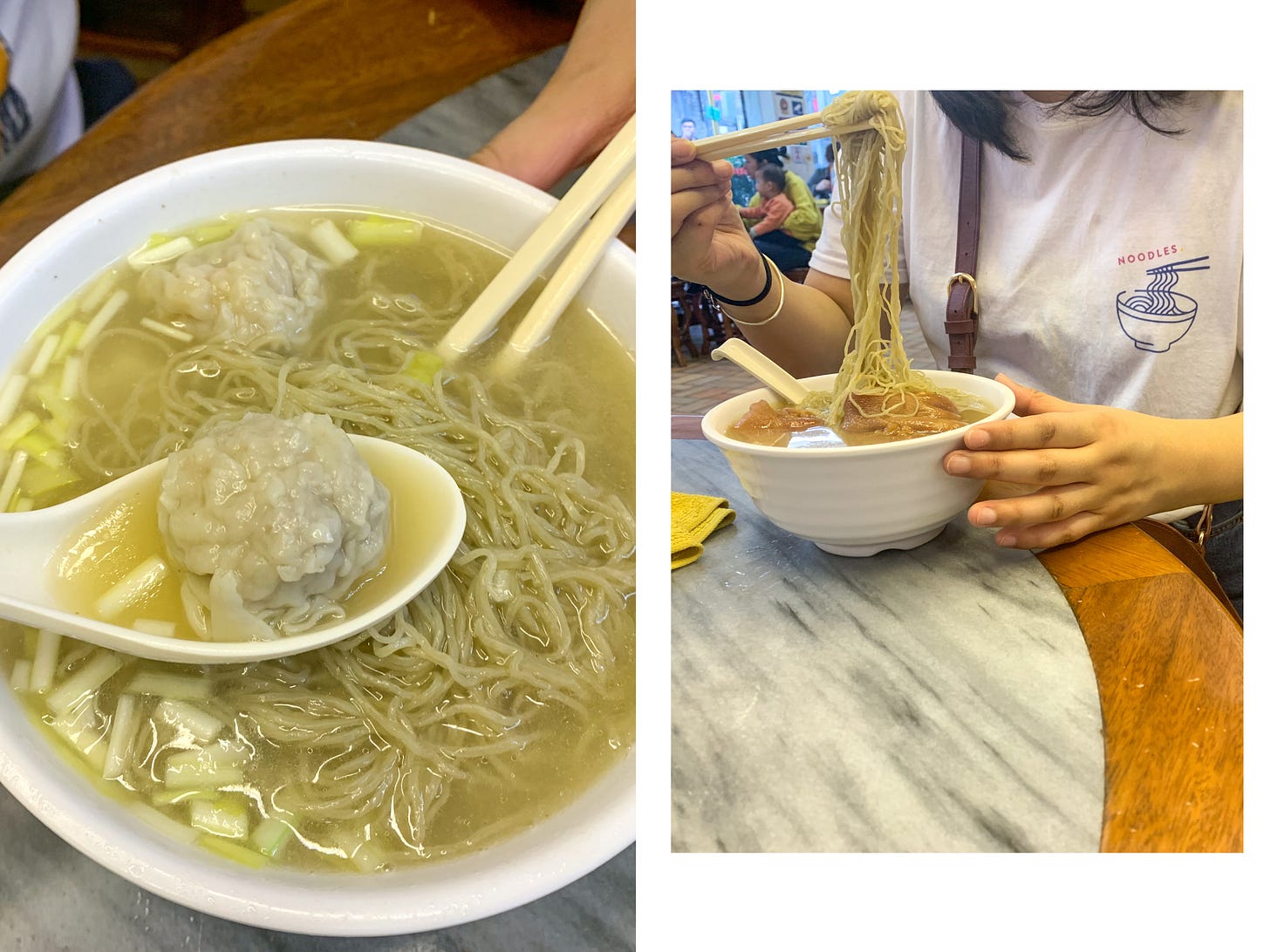

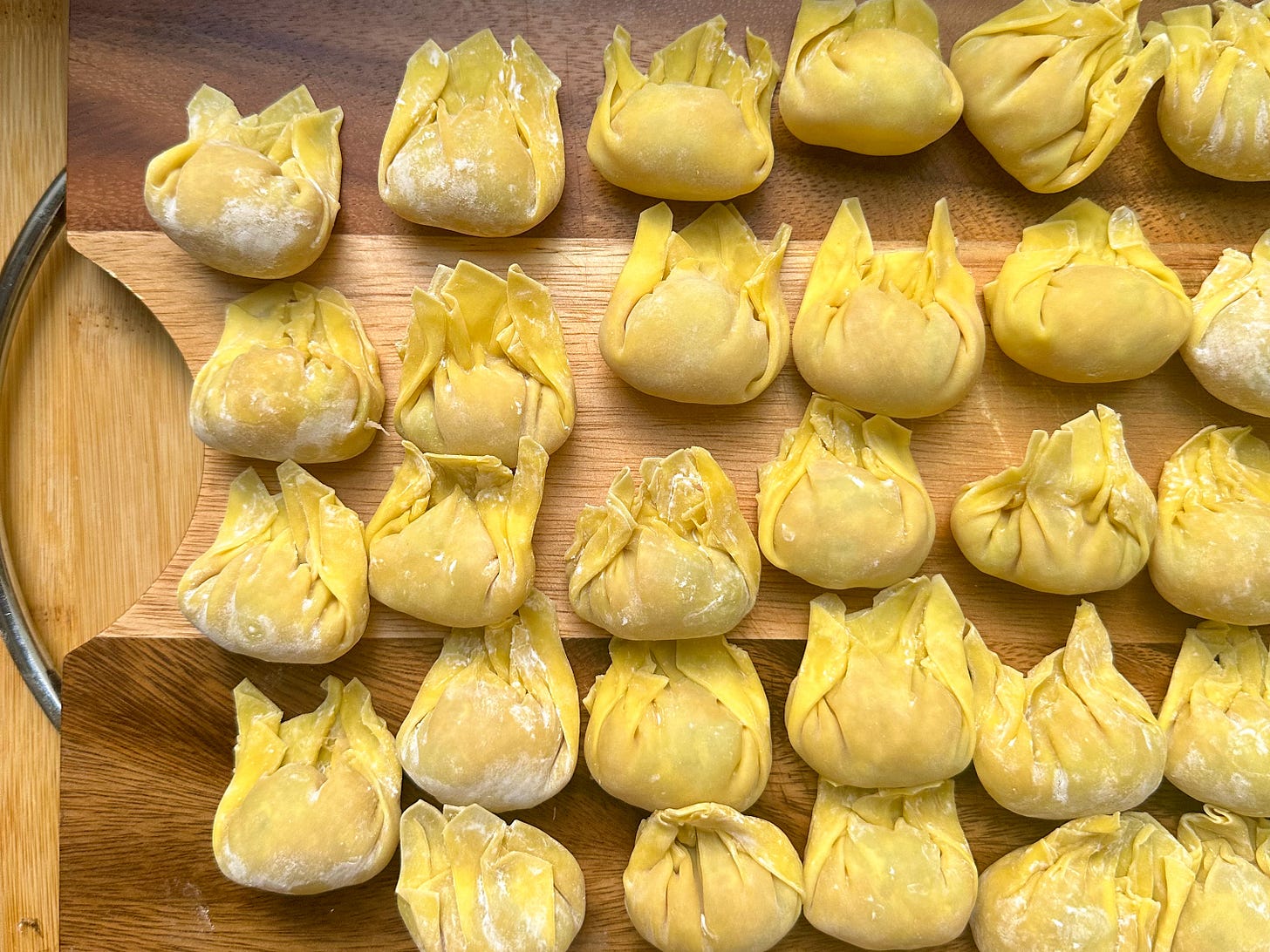
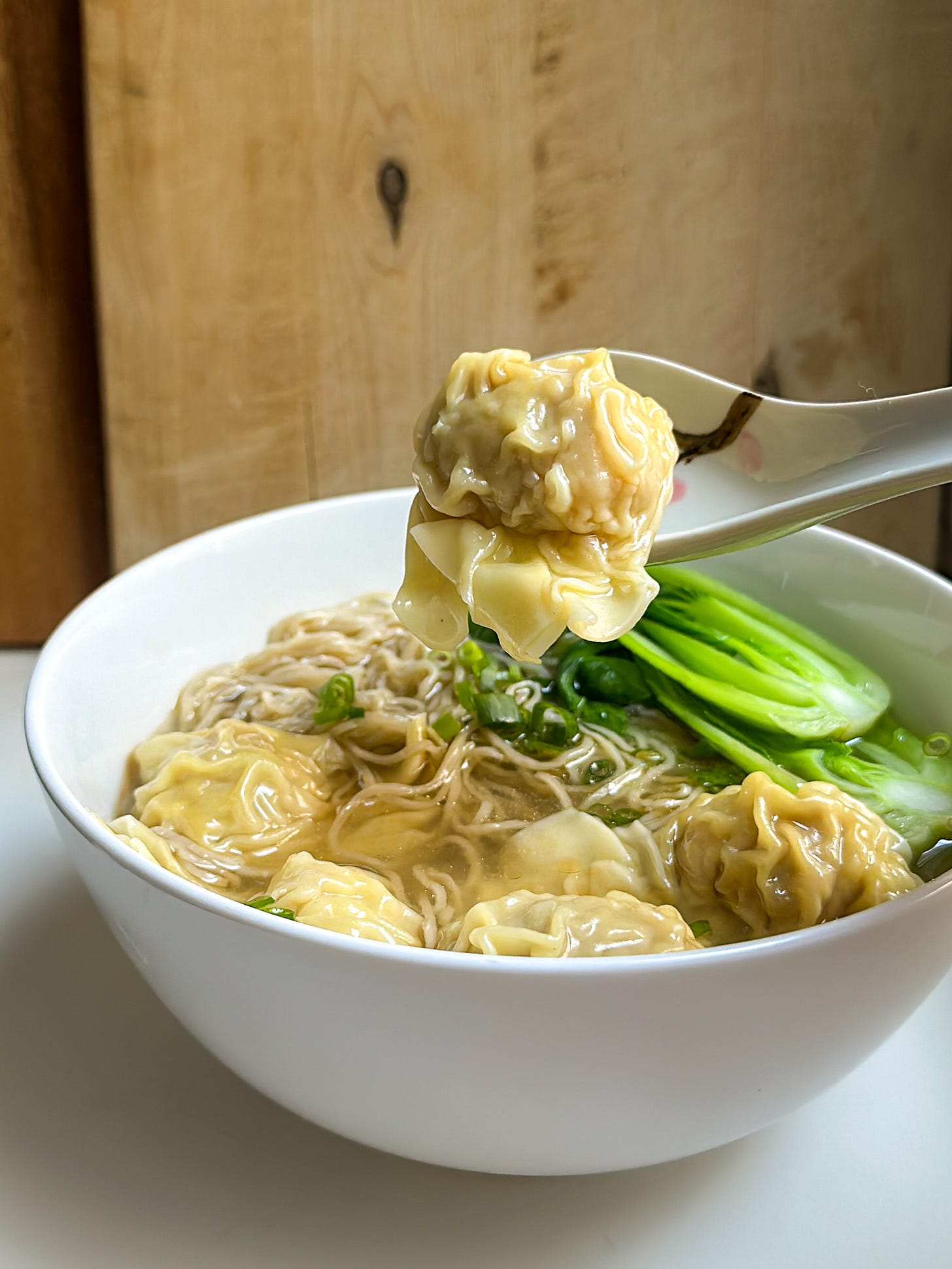
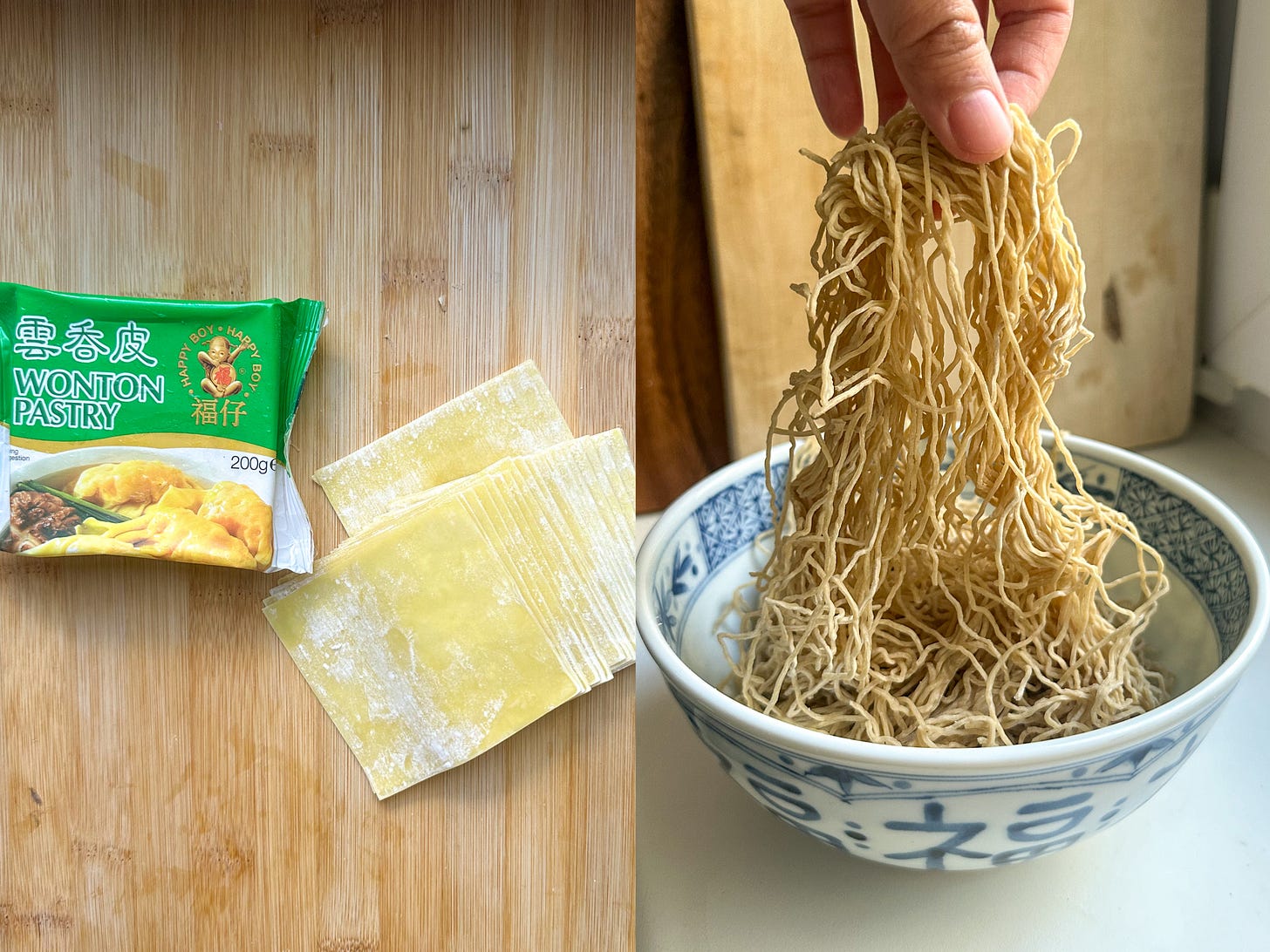



I am so, so happy I found your newsletter. This is one of my favorite things to eat. Can't wait to dedicate a day making these wontons and broth and dedicatemy whole freezer space to them ❤️
Love love this!